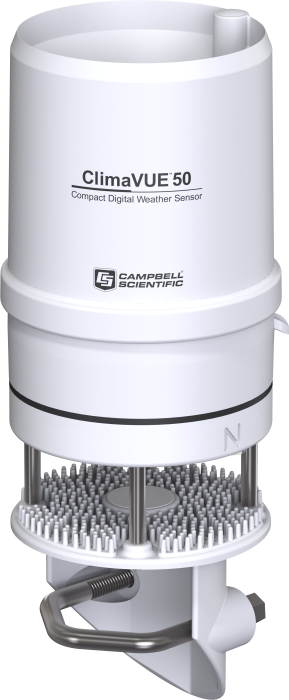This product is no longer available and has been replaced by: ClimaVue 50 G2.

| 利用できるサービス |
|---|
概要
ClimaVue™50はCampbell Scientificの柔軟性と拡張性に優れたデータ収集プラットフォームと組み合わせることで一般的な気象モニタリングのニーズをシンプルに満たす手頃な価格の複合気象センサです。このセンサはSDI-12を使用して温度、相対湿度、蒸気圧、気圧、風(速度、突風、方向)、日射量、降水量、落雷(回数と距離)を報告します。可動部がなく、消費電力も少ないです。内蔵の傾斜センサーが長期間のデータ保全性を保証します。この多様な製品は、迅速な配備、遠隔地、大規模ネットワーク、より複雑なシステムの一部として、または単にシンプルなものが必要な場合に最適です。
続きを読む利点と特徴
- 1つのシンプルなデジタル(SDI-12)出力ですべての一般的な気象測定が可能
- 平均電流は12 Vdcで1 mA以下、ソーラー発電サイトに最適
- 内蔵の傾斜センサーにより、センサーが長期間にわたって水平を保つことが可能
- 低メンテナンス-可動部品がないため、メンテナンスコストと時間を大幅に削減
- SUS304製ハードウェアにより、海洋環境での表面の汚れを最小限に抑えます。
- センサー設定不要
- コンパクトな設計により、迅速かつ低インパクトで設置可能
- 最新のCampbell Scientific製データロガーと互換性あり
- 取り外し可能なケーブルにより、現場での交換が容易
イメージ













詳細
センサ
すべてのセンサが1つの小型ユニットに統合されているため、設置にかかる労力は最小限で済みます。磨耗や汚損によるエラーを防ぐ堅牢で可動部のない設計のClimaVue 50は長期にわたる遠隔地に設置するのに理想的です。
日射計
日射量は、ClimaVue 50の上部にあるレインゲージファンネルのリップに組み込まれた日射計によって測定されます。この小型日射計はシリコンセルセンサを使用して、入射日射量(直達日射量と拡散日射量)の合計を測定します。シリコンセルセンサーは、変化する日射条件に対して優れた応答時間を持ち、日射スペクトル全体にわたって許容できる感度を持つため、ClimaVue 50での使用に適しています。
風速計
雨量計の下の空間はClimaVue 50が風速を測定する場所です。互いに直角に配置されたトランスデューサーから発せられた超音波信号は、多孔質焼結ガラス板で跳ね返り、反対側のセンサーに戻ります。音速は風の影響を受け、送信機から受信機まで音が伝わる時間の差を測定することで風速を算出します。
温度センサ
ClimaVue 50の温度測定は、風速計の中央にある4つの音波トランスデューサーの中央から小さな温度センサ(サーミスタ)を内蔵した小さなステンレス針が伸びている部分で行われます。
相対湿度センサ
ClimaVue 50の相対湿度センサは、音波トランスデューサーの近くにある円形のテフロン™スクリーンの裏側にあります。テフロンスクリーンは液体の水やほこりからセンサを保護する一方で、水蒸気がセンサを自由に通過できるようにします。ClimaVue 50は相対湿度と温度を測定し、蒸気圧を計算します。
ドリップカウンター・レインゲージ
傾斜センサ
ClimaVue 50には傾斜センサも搭載されています。傾斜センサのデータの主な用途は、ClimaVue 50 が常に水平であることを確認することです。定期的にXとYの傾斜データをチェックして、ClimaVue 50が水平であることを確認します。傾いた場合は、現場に戻って再度水平にしてください。水平から3度ずれると、雨や日射の測定に誤差が生じることがあります。このセンサの測定値を使用して設置時に機器を水平にすることもできますが、風速計プレートの底にある小さなバブルレベルを使用する方がはるかに簡単です。
取り付け
ClimaVue 50には、公称外径31.8~50.8mm(1.25~2.0インチ)のパイプに取り付けるためのVボルトが付属しています。これにより、センサを三脚マストまたはCM300シリーズの取付ポールに直接取り付けるか、17387 取付パイプキット.を使用してクロスアームに取り付けることができます。
仕様
| 計測項目 | 気温、気圧、雷の平均距離、落雷回数、降水量、相対湿度、日射量、傾斜、風向、風速 |
| 通信 | SDI-12 |
| 動作温度範囲 | -50° ~ +60°C (気圧計と相対湿度計を除く: -40° ~ +60°C.) |
| 最小供給電圧 | 3.6 Vdc 連続 |
| 最大供給電圧 | 15.0 Vdc 連続 |
| 最小デジタル入力電圧 |
|
| 標準デジタル入力電圧 |
|
| 最大デジタル入力電圧 |
|
| 12 Vdc での標準電流消費量 | < 1 mA (平均) |
| 標準測定期間 | 110 ミリ秒 |
| 最大測定期間 | 3,000 ミリ秒 |
| 最大ポーリング頻度 | 10 秒 |
| 欧州理事会指令の適用 |
|
| 適合宣言された規格 |
|
| ケーブル接続の説明 | 25 mm (10 インチ) バラ線、M12 ピン (オス) 5 ピン 316 ステンレスローレット |
| 直径 | 10 cm (4インチ)雨量計ファンネルを含む |
| 高さ | 34 cm (13.4インチ) 雨量計ファンネルを含む |
| 重さ | 839.15 g (1.85 lb) |
消費電流 |
|
| 静止時 | 0.3 mA |
| 最大ピーク電流 | 33 mA |
| 平均 @10 秒ごとに R7! コマンドを使用する場合 | 1.0 mA |
| 平均 @60 秒ごとに R7! コマンドを使用する場合 | 0.4 mA |
気温 |
|
| 測定範囲 | -50° ~ +60°C |
消費電流 |
|
| 分解能 | 0.1°C |
| 正確度 | ±0.6°C |
相対湿度 |
|
| 測定範囲 | 0 ~ 100% |
| 分解能 | 0.1 |
| 正確度 | ±3% RH 標準 (気温や湿度により異なります) |
気圧 |
|
| 気圧計の動作温度範囲 | -40° ~ +60°C |
| 測定範囲 | 500 ~ 1100 hPa |
| 分解能 | 0.1 hPa |
| 正確度 |
|
蒸気圧 |
|
| 測定範囲 | 0 ~ 47 kPa |
| 分解能 | 0.01 kPa |
| 正確度または再現性 | 温度と湿度によって異なります。40°C 未満では通常 ±0.2 kPa です。 |
風速 |
|
| 最大風速 | 突風10秒 |
| 測定範囲 | 0~30m/秒 (0~67mph) |
| 分解能 | 0.01 m/s (0.02 mph) |
| 正確度または再現性 | 0.3 m/s または 3% 0.67 mphまたは3%(いずれか大きい方) |
風向 |
|
| 測定範囲 | 0°~359° |
| 分解能 | 1° |
| 正確度 | ±5° |
日射 |
|
| 測定範囲 | 0~1750 W m-2 |
| 分解能 | 1 W m-2 |
| 正確度 | 測定値の±5% (標準) |
| スペクトル範囲 | 300~1150nm |
雨量 |
|
| 測定範囲 | 0~400mm/時 (15.75 in./h) |
| 分解能 | 0.017 mm |
| 正確度 | 測定値の±5% (0~50 mm/h または 0~1.97 in/h) |
傾斜 |
|
| 測定範囲 | -90°~+90° |
| 分解能 | 0.1° |
| 正確度 | ±1° |
落雷回数 |
|
| 測定範囲 | 0~65,535回 |
| 分解能 | 1 回 |
| 正確度 | 標準:10km未満で25%以上の検出率 (距離によって変化) |
落雷平均距離 |
|
| 測定範囲 | 0~40km (0~24.9マイル) |
| 分解能 | 3 km (1.86マイル) |
| 正確度 | 変動あり |
ドキュメント
テクニカルペーパー
ダウンロード
ClimaVue 50 Example Program v.1 (3 KB) 08-07-2021
An example CR1000X program that uses the R7! SDI-12 command to retrieve data. The program adjusts the barometric pressure measurement to sea level. The adjustment is entered as a constant in the beginning of the program. It assumes the site elevation is 1382 m, and a different value is required for different site elevations.
This program also includes instructions that set wind measurements that are less than 0 to the last valid measurement. These instructions are needed because high winds with rain can temporarily interfere with sonic wind measurements.
よくある質問
ClimaVue 50に関するよくある質問の数: 10
すべて展開すべて折りたたむ
-
ClimaVue 50 の内部では、降水量が継続的に測定されています。太陽放射、風、気温は 10 秒ごとに測定され、方位、蒸気圧、大気圧、相対湿度は 60 秒ごとに測定されます。測定間隔の 2 倍以上の頻度でセンサをクエリすると、生の値が返されます。測定間隔よりも頻繁にクエリすると、値が重複し、データロガーでタイミングの問題が発生する可能性があります。
-
ClimaVue 50 は微気候センサなので、研究課題に関連する気候を代表するように配置する必要があります。FAO56 では、センサーの配置とフィールドサイズに関する具体的なガイドラインが示されています。センサを ET の参照用として使用する場合は、そのガイドラインに従ってください。以下を参照してください。: http://www.fao.org/docrep/X0490E/X0490E00.htm.
-
ClimaVue 50 の静止状態および通常の 10 秒間の風速測定中の平均電流消費量は、約 300 µA です。60 秒ごとに aR7! コマンドでポーリングすると、平均電流消費量は 0.4 mA に増加します。10 秒ごとに aR7! コマンドでポーリングすると、平均電流消費量は 1 mA に増加します。
-
ClimaVue 50 の取り付けタイプは、気象スタンド、セメント製ポール、または三脚です。直径は 31.8 ~ 50.8 mm、1.25 ~ 2.0 インチです。ClimaVue 50 には V ボルトが取り付けられており、ほとんどの支柱、ポール、三脚などの上に取り付けることができます。レンチを使用してボルトを締め、ClimaVue 50 をスタンドの上部に平らにしっかりと固定します。日本国内で広く使用されている単管パイプにも取り付け可能です。
-
ClimaVue 50は、エネルギーバランスアプローチを使用して吸収された放射を補正するために必要なすべての情報を収集します。
-
SDI-12 には、それぞれ 200 フィートのケーブルを持つ少なくとも 10 個のセンサを接続できます。センサの数が少ないほど、ケーブル長を長くすることができます。
-
推奨事項については、マニュアルのメンテナンス セクションを参照してください。
-
すべてのセンサに異なるケーブル終端オプションがあるわけではありません。特定のセンサで利用可能なオプションは、センサ製品ページの注文情報エリアの 2 つの場所で確認できます。
モデル番号
ケーブル終端オプション リスト
センサが –ET、–ETM、–LC、–LQ、または –QD バージョンで提供されている場合、そのオプションが利用可能かどうかはセンサモデル番号に反映されます。たとえば、034B は 034B-ET、034B-ETM、034B-LC、034B-LQ、および 034B-QD として提供されています。その他のすべてのケーブル終端オプション (利用可能な場合) は、センサ製品ページの注文情報エリアの「ケーブル終端オプション」の下にリストされています。たとえば、034B-L 風力発電セットは、034B-L 製品ページの注文情報エリアに示されているように、–CWS、–PT、および –PW オプションで提供されています。
注意: 新しい製品が在庫に追加されると、通常は複数のモデル番号を作成するのではなく、1 つのセンサモデルの下に複数のケーブル終端オプションをリストします。たとえば、HC2S3-L には、HC2S3-LC モデルではなく、CS110 に接続するための –C ケーブル終端オプションがあります。
-
現時点では、ClimaVue 50 のヒータバージョンはありません。気温を補正するモデルはエネルギーバランスに基づいており、放射センサと風速センサが信頼性の高いデータを収集できるすべての状況で有効です。ただし、意図せず雪や氷に埋もれると、両方の機能が妨げられる可能性があります。ClimaVue 50 は、すべての気候に普遍的に適合するわけではありません。研究で冬の降水量が重要な場合は、他の機器が必要になります。
-
ClimaVue 50 は、定期的な風速測定 (10 秒ごと) と風向の測定を行うために、継続的に電源を供給する必要があります。風速と風向の測定を組み合わせると、風は本質的に変化するため、電源を入れてすぐに測定値を取得するだけでは、風速と風向の測定値にはほとんど価値がありません。Campbell Scientific は、信頼性の高い風速測定を行うために、ClimaVue 50 機器に継続的に電源を供給することを強くお勧めします。静止状態および定期的な 10 秒間の風速測定中の ClimaVue 50 の平均電流消費量は約 300 マイクロアンペアであるため、継続的な電源供給によるバッテリー消費は最小限に抑えられます。
ケーススタディ
概要 2020年、COVID-19パンデミックの影響により、F1世界選手権のカレンダーは大幅に変更され、いくつかのレースが中止され、いくつかの新しい会場が追加されました。 新しいレース会場の一つは、1996年以来初めてポルトガルF1グランプリを開催したアウトドローモ・インテルナシオナル・ド・アルガルヴェです。 これにより、路面温度 (RST) を監視する機能を含む新しい気象観測所を設置して、トラックのインフラストラクチャを強化する絶好の機会が生まれました。 Campbell Scientific のソリューションは、すぐに導入できるセットアップで、さまざまなパラメータにわたって正確なリアルタイム データをトラック所有者に提供しました。KonectGDS の明確なデータ視覚化により、情報を簡単に配布できるようになりました。このソリューションは、厳しい時間枠内でインストールされ、トラックのインフラストラクチャを大幅に変更する必要がなかったため、Campbell Scientific ソリューションの汎用性と有効性が実証されました。 課題 天候はモータースポーツに大きな影響を与え、安全性、パフォーマンス、レース戦略に影響を与えます。そのため、天候と道路状況の観測システムは、レースチーム、レース管理マネージャー、トラック所有者にとって重要なツールとなり、レースイベント中にリアルタイムのデータを提供して、より正確な現在予測とより正確な現地の気象パターン予測を可能にします。長期的な現地の気象パターンに関する知識を深めることは、トラック所有者にとって非常に貴重であり、レースやプライベートテストイベントのスケジュール設定に重要な情報を顧客に提供できます。 RST を含む包括的な範囲のパラメータを監視するソリューションが必要でした。ソリューションは、以下の基準も満たす必要がありました。 視覚的および空間的な影響を最小限に抑えるコンパクトなパッケージです。 非侵襲的な RST モニタリングが可能であること。 情報への一般公開のための Web ベースのプラットフォームを含めます。......続きを読む
Solar energy is the most abundant clean energy source available on earth, but the intermittent......続きを読む
概要 問題 バーミンガム大学は、バーミンガム市民のための教育ポータルおよび監視ステーションとして機能するため、市内に 26 の気象観測所を設置し、運用していました。時間が経ち、何年も使用された結果、これらの観測所は老朽化し、必要なデータを提供できなくなっていました。システムを最新化し、アップグレードし、保守して標準に引き上げ、市に価値を提供し続けるようにする必要がありました。 小学校、大学の敷地、自然保護区、住宅地など、さまざまな場所に設置されており、2 つのサイトが同じではないため、サービス提供に課題が生じていました。一部のステーションにはエンクロージャが欠落しており、一部の重要なコンポーネントのサービスが断続的だったため、障害やデータ不足が発生していました。 解決 Campbell Scientific はバーミンガム大学と協力し、バーミンガム市内の多数の場所にある 26 の気象ステーションを、最新の ClimaVue™50 デジタル センサー、電源供給の確実性を高める大型の SP30 ソーラー パネル、および CELL215......続きを読む
記事とプレスリリース
ブログ記事
-
But It’s a Dry Heat… like a Furnace

21-06-2021 著者: Dirk Baker -
No Compromise: Quality Weather Measurements and Simplicity

17-10-2018 著者: Robin Deissinger
Privacy Policy Update
We've updated our privacy policy. 詳細はこちら
Cookie Consent
Update your cookie preferences. クッキーの設定を更新する
















